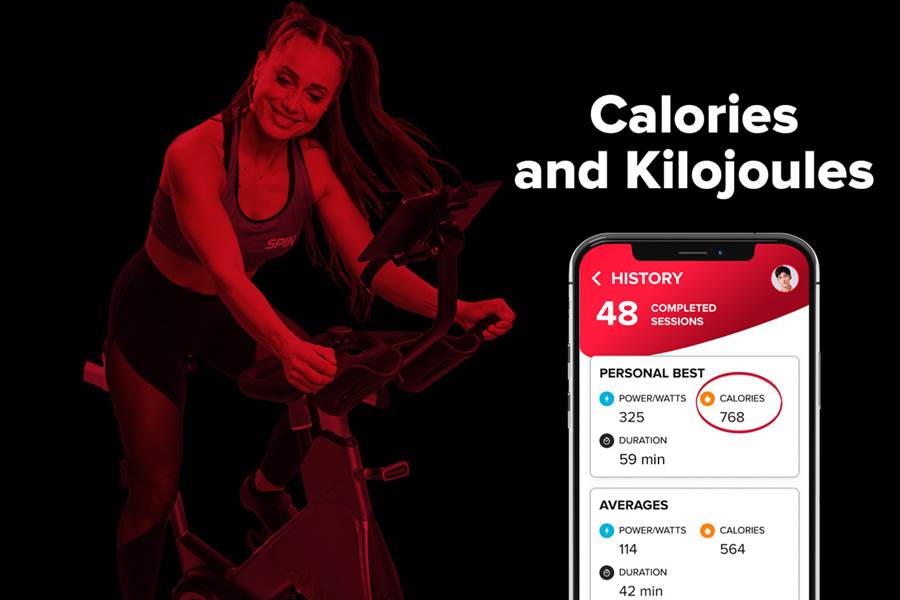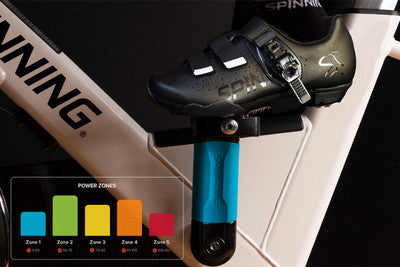You’ve just finished a sweaty Spinning® ride, and your workout summary displays the total calories burned. Awesome. You achieved your goal, and you feel great about the accomplishment. But you’re also wondering why you seem to burn more calories on the treadmill at the gym…even with a light jog!
You’re also curious about this thing called kJs. What’s that number and how is it related to energy expenditure?
Let’s answer these questions and get you ready to ride with accurate metrics so you can hit those fitness goals like the champ we know you are!
| This article supports the Spinning® app with the Spinning® Plus Subscription Plan. To learn more about our apps and start a subscription visit Spinning.com/rideathome |
Calories and kJs
Chances are you know what calories are, and you know the usefulness of seeing how many calories you burn in a workout. Now how about Kilojoules (kJs)? Are you wondering why this term from your Physics class days is appearing on your cycling app? How are calories and kJs related, and what does each number represent?
Let’s start with the short answer: kJs represents the amount of calories you burned actually doing the work in your workout. Calories represents the total number of calories burned in that hour (or however long your workout was). Because remember – your body is burning calories ALL the time! Even as you sit here reading this article. Even as you sleep! So if you sat still and meditated on that bike for an hour instead of tackling those hills and breakaways, you still would have burned some calories.
For example: Let’s say you complete a 45-minute ride and your Spinning® app shows a total of 450 kJs. The kJs represents the actual work you did on the bike; you burned 450 calories by putting the work into the pedals. You also burned an additional 1-ish calories per minute just for basic metabolism—let's just say 50 calories to keep it simple. So the total calories burned in that 45 minutes is 500, but the 450 calories (kJs) it took to do the workout is probably a more meaningful number.
Side note: This is similar to something you may have seen in other apps or devices. On an Apple Watch, for instance, the workout tracker will report your Active Calories and Total Calories.
How are kJs and Calories Determined?
![]()
When you ride a Spinner® bike equipped with a power crank, the crank measures your power in watts. That’s pretty straightforward. Now let’s nail down some definitions: A joule is defined as watts x seconds, and a Kilojoule (kJ) is 1,000 joules. So the total volume of your power output is expressed in kJs. And here’s how we connect the dots to caloric expenditure: It’s widely accepted that for all practical purposes, there’s a 1:1 ratio between kJs and calories burned. The reason behind this is that 1 Calorie = 4.184 kJs, but the human body is only about 24% efficient at transforming energy into work, so with a little math where we end up is that 1 kJ measured in a workout = 1 food Calorie burned.
So when you ride a Spinner® bike with power, your app or console will display your total kJs and that equates to the calories burned to do the workout.
![]()
When there’s no power measurement involved and a workout app or cardio machine displays calories burned, that number comes from a formula that takes into account data available, and ideally the data includes the intensity and duration of the workout, and the individual’s metabolic rate. When there is sufficient data used in the calculation, the result can be pretty accurate.
Caution: In many cases, fitness apps and machines don’t have any data points other than the workout duration, and therefore they obviously won’t produce a number that you can rely on. Think about those times when you’ve jogged on a treadmill without wearing a heart rate monitor and without putting any personal info into the console, and have been pleasantly surprised to “learn” that you burned 1,000 calories in half an hour.
The Spinning® app estimates your calories burned using a formula that includes your heart rate (for intensity), and your age, sex and weight (to estimate metabolism).
So when you wear a heart rate monitor during your ride, and you input your age, sex and weight into your profile, the Spinning® app has sufficient data to give a good estimate of the total calories burned during the workout.
Let’s recap Calories and kJs in the Spinning® app:
- If you ride with power you’ll see kJs, which equates to the workout calories burned.
- If you ride without power, but you’re wearing a heart rate monitor, you’ll see an estimate of your total calories burned.
Ready to Ride? You can equip your Spinner® Bike for power measurement by adding a SPIN® Power crank, and pairing it to the Spinning® app. The crank and the app combined will give you all the quantifiable info you need to track, measure, and progress toward those legit fitness goals you seek to achieve. You can do it – ride on!
Read more about why and how to add power to your training: Spinning® + Power = SPINPower®





Leave a comment
This site is protected by hCaptcha and the hCaptcha Privacy Policy and Terms of Service apply.